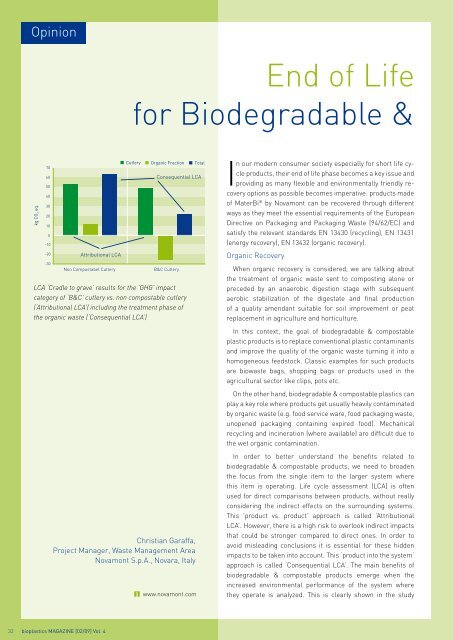bioplasticsMAGAZINE_0902
bioplasticsMAGAZINE_0902
bioplasticsMAGAZINE_0902
Create successful ePaper yourself
Turn your PDF publications into a flip-book with our unique Google optimized e-Paper software.
Opinion<br />
End of Life<br />
for Biodegradable &<br />
kg CO 2<br />
eq.<br />
70<br />
60<br />
50<br />
40<br />
30<br />
20<br />
10<br />
0<br />
-10<br />
-20<br />
-30<br />
Attributional LCA<br />
Non Compostabel Cutlery<br />
Cutlery<br />
Organic Fraction<br />
LCA ‘Cradle to grave’ results for the ‘GHG’ impact<br />
category of ‘B&C’ cutlery vs. non compostable cutlery<br />
(‘Attributional LCA’) including the treatment phase of<br />
the organic waste (‘Consequential LCA’)<br />
Christian Garaffa,<br />
Project Manager, Waste Management Area<br />
Novamont S.p.A., Novara, Italy<br />
www.novamont.com<br />
Total<br />
Consequential LCA<br />
B&C Cutlery<br />
In our modern consumer society especially for short life cycle<br />
products, their end of life phase becomes a key issue and<br />
providing as many flexible and environmentally friendly recovery<br />
options as possible becomes imperative: products made<br />
of MaterBi ® by Novamont can be recovered through different<br />
ways as they meet the essential requirements of the European<br />
Directive on Packaging and Packaging Waste (94/62/EC) and<br />
satisfy the relevant standards EN 13430 (recycling), EN 13431<br />
(energy recovery), EN 13432 (organic recovery).<br />
Organic Recovery<br />
When organic recovery is considered, we are talking about<br />
the treatment of organic waste sent to composting alone or<br />
preceded by an anaerobic digestion stage with subsequent<br />
aerobic stabilization of the digestate and final production<br />
of a quality amendant suitable for soil improvement or peat<br />
replacement in agriculture and horticulture.<br />
In this context, the goal of biodegradable & compostable<br />
plastic products is to replace conventional plastic contaminants<br />
and improve the quality of the organic waste turning it into a<br />
homogeneous feedstock. Classic examples for such products<br />
are biowaste bags, shopping bags or products used in the<br />
agricultural sector like clips, pots etc.<br />
On the other hand, biodegradable & compostable plastics can<br />
play a key role where products get usually heavily contaminated<br />
by organic waste (e.g. food service ware, food packaging waste,<br />
unopened packaging containing expired food). Mechanical<br />
recycling and incineration (where available) are difficult due to<br />
the wet organic contamination.<br />
In order to better understand the benefits related to<br />
biodegradable & compostable products, we need to broaden<br />
the focus from the single item to the larger system where<br />
this item is operating. Life cycle assessment (LCA) is often<br />
used for direct comparisons between products, without really<br />
considering the indirect effects on the surrounding systems.<br />
This ‘product vs. product’ approach is called ‘Attributional<br />
LCA’. However, there is a high risk to overlook indirect impacts<br />
that could be stronger compared to direct ones. In order to<br />
avoid misleading conclusions it is essential for these hidden<br />
impacts to be taken into account. This ‘product into the system’<br />
approach is called ‘Consequential LCA’. The main benefits of<br />
biodegradable & compostable products emerge when the<br />
increased environmental performance of the system where<br />
they operate is analyzed. This is clearly shown in the study<br />
32 bioplastics MAGAZINE [02/09] Vol. 4


















